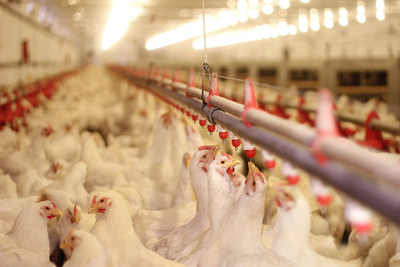
Recent research by World Animal Protection highlights how significant a role Canada’s agricultural sector plays in emissions, and how reducing meat production and consumption can be the key to hitting Canada’s climate targets in 2030 and 2050.
TORONTO, Nov. 9, 2022 /CNW/ – This week, one of the topics discussed at COP27 in Egypt is the need for the world to address the role of agriculture in the global climate crisis.

Canada’s reporting of its agriculture-related emissions is not comprehensive, with some of the emissions being classified under other industry sectors, including emissions from feed production, fertilizer production and fertilizer use, which are reported under ‘heavy industry’.
This hides the true impact of the agricultural sector.
Recent research by Navius, commissioned by World Animal Protection shows Canada produces 91 megatonnes of CO2 emissions from its combined agricultural sectors. That’s the equivalent of 19.6 million cars being driven annually in terms of greenhouse gas emissions.
This research was the first of its kind as it quantifies the real amount Canada’s agriculture sector emits in greenhouse gasses.
“Industrial animal agriculture is one of the largest drivers of agricultural-related greenhouse gas emissions,” said Lynn Kavanagh, World Animal Protection’s Farming Campaign Manager. “This silent climate culprit in the world’s biggest economies, including Canada, releases disproportionate emissions with a global impact, affecting countries and communities in less developed areas like Africa – even though they do not contribute to the problem.”
World Animal Protection is urging governments attending COP27, including Canada, to stop building new industrial farming systems and to make higher animal welfare compulsory in existing facilities to prevent animal suffering.
According to the Navius research, if Canadians move from a high-meat consumption diet to a low-meat consumption one, the impacts on greenhouse gas emissions would be significant enough to put Canada back on track to meet its 2030 and 2050 climate targets. The move would reduce emissions across the agricultural industry by 13.5 megatons by 2030, or the equivalent of taking nearly 6 million cars off the road annually.
A recent report by Boston Consulting Group, reinforces the magnitude of this shift. It found scaling up meat and dairy alternatives can result in an 11 times larger reduction in emissions than zero emission vehicles.
“Reducing animal agriculture in the food value chain is a high-impact, low-cost solution to the global climate crisis,” added Kavanagh.
For everyday Canadians, eating less meat and dairy is a powerful and meaningful way for individuals to have a positive impact, reduce their contribution to climate change, improve biodiversity and their own health.
Experts predict that without urgent and drastic shifts in global meat consumption, agriculture will consume the entire world’s carbon budget necessary for keeping global temperature rises under 2°C by 2050.
World Animal Protection has spokespeople available to discuss the role of agriculture in the climate crisis and the need for governments to take action.

SOURCE World Animal Protection

Back | Next story: Leschaco selects WAVE BL to power its all-digital House Bills of Lading